Yamaha PSR-410 User Manual
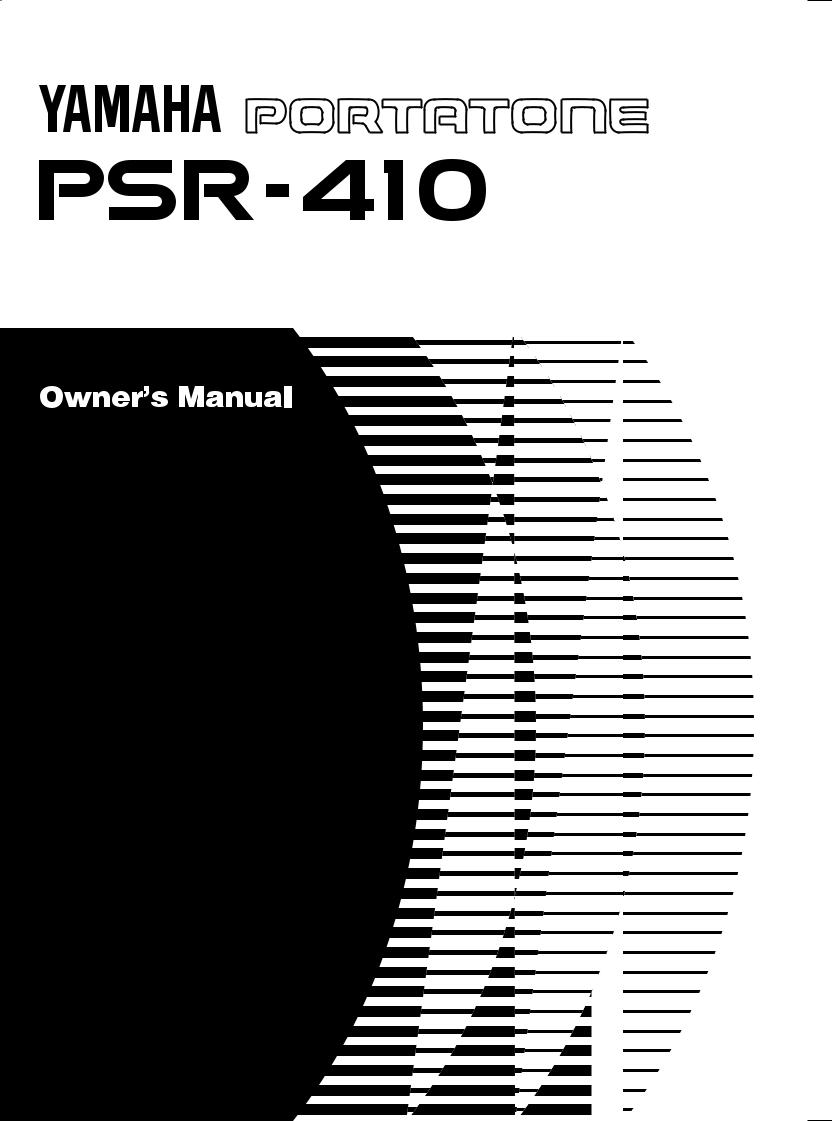

SPECIAL MESSAGE SECTION
This product utilizes batteries or an external power supply (adapter). DO NOT connect this product to any power supply or adapter other
than one described in the manual, on the name plate, or specifically recommended by Yamaha.
This product should be used only with the components supplied or; a cart, rack, or stand that is recommended by Yamaha. If a cart, etc., is used, please observe all safety markings and instructions that accompany the accessory product.
SPECIFICATIONS SUBJECT TO CHANGE:
The information contained in this manual is believed to be correct at the time of printing. However, Yamaha reserves the right to change or modify any of the specifications without notice or obligation to update existing units.
This product, either alone or in combination with an amplifier and headphones or speaker/s, may be capable of producing sound levels that could cause permanent hearing loss. DO NOT operate for long periods
of time at a high volume level or at a level that is uncomfortable. If you experience any hearing loss or ringing in the ears, you should consult
an audiologist.
IMPORTANT: The louder the sound, the shorter the time period before damage occurs.
NOTICE:
Service charges incurred due to a lack of knowledge relating to how a function or effect works (when the unit is operating as designed) are not covered by the manufacturer’s warranty, and are therefore the owners responsibility. Please study this manual carefully and consult your
dealer before requesting service.
ENVIRONMENTAL ISSUES:
Yamaha strives to produce products that are both user safe and environmentally friendly. We sincerely believe that our products and the production methods used to produce them, meet these goals. In keeping with both the letter and the spirit of the law, we want you to be aware of the following:
Battery Notice:
This product MAY contain a small non-rechargeable battery which (if applicable) is soldered in place. The average life span of this type of
battery is approximately five years. When replacement becomes necessary, contact a qualified service representative to perform the replacement.
This product may also use “household” type batteries. Some of these may be rechargeable. Make sure that the battery being charged is a rechargeable type and that the charger is intended for the battery being charged.
When installing batteries, do not mix batteries with new, or with batteries of a different type. Batteries MUST be installed correctly. Mismatches or incorrect installation may result in overheating and battery case rupture.
Warning:
Do not attempt to disassemble, or incinerate any battery. Keep all batteries away from children. Dispose of used batteries promptly and
as regulated by the laws in your area. Note: Check with any retailer of household type batteries in your area for battery disposal information.
Disposal Notice:
Should this product become damaged beyond repair, or for some
reason its useful life is considered to be at an end, please observe all local, state, and federal regulations that relate to the disposal of products that contain lead, batteries, plastics, etc. If your dealer is unable to assist you, please contact Yamaha directly.
NAME PLATE LOCATION:
The name plate is located on the bottom of the product. The model number, serial number, power requirements, etc., are located on this plate. You should record the model number, serial number, and the date of purchase in the spaces provided below and retain this manual as a permanent record of your purchase.
Model
Serial No.
Purchase Date
PLEASE KEEP THIS MANUAL
|
FCC INFORMATION |
(U.S.A.) |
|
IMPORTANT NOTICE: DO NOT MODIFY THIS UNIT! |
the instructions found in the users manual, may cause interference |
||
This product, when installed as indicated in the instructions contained in |
harmful to the operation of other electronic devices. Compliance with |
||
this manual, meets FCC requirements. Modifications not expressly ap- |
FCC regulations does not guarantee that interference will not occur in |
||
proved by Yamaha may void your authority, granted by the FCC, to use |
all installations. If this product is found to be the source of interference, |
||
the product. |
|
which can be determined by turning the unit “OFF” and “ON”, please try |
|
|
|
to eliminate the problem by using one of the following measures: |
|
IMPORTANT |
: |
• Relocate either this product or the device that is being affected by the |
|
When connecting this product to accessories and/or another product use |
|||
interference. |
|||
only high quality shielded cables. Cable/s supplied with this product |
|||
|
|||
MUST be used. Follow all installation instructions. Failure to follow in- |
• Utilize power outlets that are on different branch (circuit breaker or |
||
structions could void your FCC authorization to use this product in the |
fuse) circuits or install AC line filter/s. |
||
USA. |
|
• In the case of radio or TV interference, relocate/reorient the antenna. |
|
|
|
||
NOTE: |
|
If the antenna lead-in is 300 ohm ribbon lead, change the lead-in to |
|
|
co-axial type cable. |
||
This product has been tested and found to comply with the requirements |
|||
|
|||
listed in FCC Regulations, Part 15 for Class “B” digital devices. Compli- |
If these corrective measures do not produce satisfactory results, please |
||
ance with these requirements provides a reasonable level of assurance |
contact the local retailer authorized to distribute this type of product. If |
||
that your use of this product in a residential environment will not result in |
you can not locate the appropriate retailer, please contact Yamaha |
||
harmful interference with other electronic devices. This equipment gener- |
Corporation of America, Electronic Service Division, 6600 |
||
ates/uses radio frequencies and, if not installed and used according to |
Orangethorpe Ave, Buena Park, CA90620 |
||
• This applies only to products distributed by Yamaha Corporation of America.

Congratulations!
You are the proud owner of a Yamaha PSR-410. Your PSR-410 is a high-qual- ity musical instrument that incorporates advanced Yamaha digital technology and many versatile features. In order to obtain maximum performance and enjoyment from your PSR-410, we urge you to read this Owner’s Manual thoroughly while trying out the various features described. Keep the Owner’s Manual in a safe place for later reference.
Contents
Panel Controls |
2 |
Taking Care of Your PortaTone |
4 |
Preparation |
5 |
■ Power Supply .................................................................. |
5 |
■ Using Headphones Or an External Sound System ......... |
6 |
■ The Sustain Pedal ........................................................... |
6 |
■ The Music Stand ............................................................. |
6 |
Listen to the Demo! |
7 |
Basic Editing Procedure |
8 |
Selecting & Playing the Voices |
10 |
■ Orchestration ................................................................ |
10 |
■ Voice Assignment ......................................................... |
12 |
■ Volume .......................................................................... |
13 |
■ Octave ........................................................................... |
13 |
■ Pan ................................................................................ |
14 |
■ Auto Harmony ............................................................... |
15 |
■ Keyboard Percussion .................................................... |
16 |
■ Pitch Bend ..................................................................... |
17 |
■ Sustain .......................................................................... |
17 |
Overall Control |
18 |
■ Split Point Change ......................................................... |
18 |
■ Transpose ..................................................................... |
19 |
■ Tuning ........................................................................... |
19 |
■ Touch Response ........................................................... |
19 |
Auto Accompaniment |
20 |
■ Selecting a Style ........................................................... |
20 |
■ Setting the Auto Accompaniment Split Point ................ |
21 |
■ Auto Accompaniment Fingering .................................... |
21 |
■ Tempo Control .............................................................. |
24 |
■ Accompaniment Control ................................................ |
25 |
■ Accompaniment Volume ............................................... |
27 |
■ The Track Buttons ......................................................... |
28 |
■ Re-voicing the Tracks ................................................... |
29 |
One Touch Setting |
30 |
Registration Memory |
|
31 |
Record Functions |
|
32 |
Song Memory .................................................................... |
|
32 |
■ Accompaniment Track Recording ................................. |
|
33 |
■ Melody Track Recording ............................................... |
|
35 |
■ Accompaniment And Melody Playback ......................... |
36 |
|
■ The [RESET] Button ..................................................... |
|
37 |
■ Record Or Play from a Specified Measure ................... |
37 |
|
The Multi Pads .................................................................. |
|
38 |
■ Recording ...................................................................... |
|
38 |
■ Playback ....................................................................... |
|
39 |
Clearing Tracks ................................................................ |
|
40 |
Page Memory |
|
41 |
MIDI |
|
42 |
MIDI Bulk Dump ................................................................ |
|
43 |
■ Page Copy .................................................................... |
|
44 |
MIDI Reception Mode |
s ..................................................... |
45 |
■ Channel Reception Modes ............................................ |
|
45 |
■ Clock Mode ................................................................... |
|
46 |
■ Start/Stop Mode ............................................................ |
|
46 |
MIDI Transmission ............................................................ |
|
47 |
■ MIDI Transmit Channels ............................................... |
|
47 |
Appendix ............................................................................... |
|
48 |
■ Voice & Polyphony List ................................................. |
|
48 |
■ Style List ....................................................................... |
|
49 |
■ Reset Procedures & Page Memory Default Settings .... |
51 |
|
■ Troubleshooting ............................................................ |
|
53 |
Index ................................................................................ |
|
54 |
Percussion Kit List .......................................................... |
|
218 |
MIDI Implementation Chart ............................................ |
|
220 |
Specifications ................................................................. |
|
223 |
| | | | | | | | | | | | | | | | | | | | | | | | | | | | | | | | | | | | | | | | | | | | | | | | | | | | | | | | | | | | | | | | | | | | | | | | | | | | | | | | | | | | | | | | | | | | | | | | | | | | | | | | | | | | | | | | | | | | | | | | | | | | | | | | | | | | | | | | | | | | | |
1 |
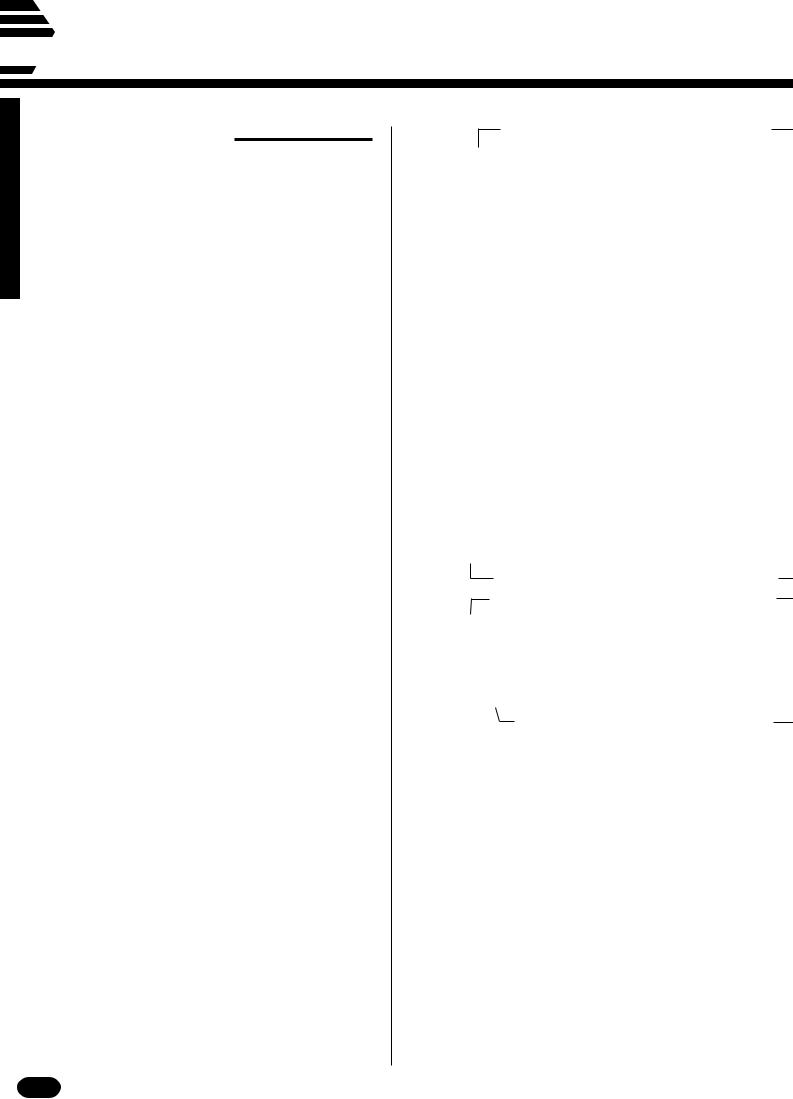
 Panel Controls
Panel Controls
Top Panel Controls
1POWER Button ............................................... |
page 7 |
|
2MASTER VOLUME Control ............................ |
page 7 |
|
3MULTI DISPLAY .......................................... |
page 7,8 |
|
4[+], [–] Buttons ................................................ |
page 9 |
|
5Number Buttons [0]~[9], [+/–] ........................ |
page 9 |
|
6ARE YOU SURE ? [YES], [NO] Buttons |
page 40, 43, 44 |
|
......................................................... |
|
|
7PITCH BEND Wheel .................................... |
page 17 |
|
8PAGE MEMORY Section |
|
|
• |
PAGE# Button ............................................ |
page 41 |
• MIDI BULK DUMP/PAGE COPY Button ... |
page 43, 44 |
|
9OVERALL CONTROL Section |
|
|
• |
TEMPO Button .......................................... |
page 24 |
• |
METRONOME Button ............................... |
page 24 |
• |
SPLIT POINT Button ................................. |
page 18 |
• |
TRANSPOSE Button ................................. |
page 19 |
• |
TUNING Button ......................................... |
page 19 |
• |
TOUCH RESPONSE Button ..................... |
page 19 |
0MIDI Section |
|
|
• |
RECEIVE CH/CL/COM Button .......... |
page 45, 46 |
• |
TRANSMIT CH Button .............................. |
page 47 |
!AUTO ACCOMPANIMENT Section |
|
|
• |
STYLE SELECT Button ............................ |
page 20 |
• |
AUTO ACCOMP Button ............................ |
page 21 |
• |
FINGERING Button ................................... |
page 21 |
• |
ACCOMP VOLUME Button ....................... |
page 27 |
• |
REVOICE Button ....................................... |
page 29 |
• |
TRACK (RHYTHM1, 2, BASS, |
|
|
RHYTHMIC CHORD 1, 2, PAD |
|
|
CHORD, PHRASE1, 2) Buttons ................ |
page 28 |
@ACCOMPANIMENT CONTROL Section |
|
|
• |
SYNC-START/STOP Button ..................... |
page 25 |
• |
START/STOP Button ................................. |
page 25 |
• |
INTRO Button ............................................ |
page 26 |
• |
FILL IN 1 Button ........................................ |
page 26 |
• |
FILL IN 2 Button ........................................ |
page 26 |
• |
ENDING Button ......................................... |
page 27 |
• |
MAIN A/B Buttons ..................................... |
page 26 |
#VOICE Section |
|
|
• |
VOICE SELECT Button ............................. |
page 12 |
• |
KEYBOARD PERCUSSION Button .......... |
page 16 |
• |
VOL Button ................................................ |
page 13 |
• |
OCTAVE Button ......................................... |
page 13 |
• |
PAN Button ................................................ |
page 14 |
• |
ONE TOUCH SETTING Button ................. |
page 30 |
• |
ORCHESTRATION R1, R2, L1, L2, |
|
|
EDIT Buttons ...................................... |
page 10, 11 |
• |
HARMONY TYPE Button .......................... |
page 15 |
• |
HARMONY Button ..................................... |
page 15 |
2 | | | | | | | | | | | | | | | | | | | | | | | | | | | | | | | | | | | | | | | | | | | | | | | | | | | | | | | | | | | | | | | | | | | | | | | | | | | | | | | | | | | | | | | | | | | | | | | | | | | | | | | | | | | | | | | | | | | | | | | | | | | | | | | | | | | | | | | | | | | | |

$REGISTRATION MEMORY Section |
|
|
• |
MEMORIZE Button ................................... |
page 31 |
• |
[1]~[4] Buttons ........................................... |
page 31 |
%SONG MEMORY Section |
|
|
• |
MEASURE# Button ................................... |
page 37 |
• TRACK (ACCOMP, MELODY) Buttons . |
page 33~36 |
|
^SONG Section |
|
|
• |
RESET Button ........................................... |
page 37 |
• |
PLAY/STOP Button ................................... |
page 36 |
&RECORDING Section |
|
|
• |
REC Button ................................... |
page 33, 35, 38 |
• |
CLEAR Button ........................................... |
page 40 |
*DEMO Section |
|
|
|
|
|
||
• |
SONG# Button ............................................ |
page 7 |
|
• |
START/STOP Button ................................... |
page 7 |
|
(MULTI PADS Section |
|
|
|
• |
STOP Button ............................................. |
page 39 |
|
• |
PAD [1]~[4] Buttons ............................ |
page 38, 39 |
|
Rear Panel Connectors
)MIDI OUT and IN Connectors ...................... |
page 42 |
qSUSTAIN PEDAL Jack ................................... |
page 6 |
wHEADPHONES/AUX OUT Jack ..................... |
page 6 |
eDC 10-12V IN Jack ......................................... |
page 5 |
| | | | | | | | | | | | | | | | | | | | | | | | | | | | | | | | | | | | | | | | | | | | | | | | | | | | | | | | | | | | | | | | | | | | | | | | | | | | | | | | | | | | | | | | | | | | | | | | | | | | | | | | | | | | | | | | | | | | | | | | | | | | | | | | | | | | | | | | | | | | | |
3 |

 Taking Care of Your PortaTone
Taking Care of Your PortaTone
Your PortaTone will give you years of playing pleasure if you follow the simple rules given below:
■ Location
Do not expose the instrument to the following conditions to avoid deformation, discoloration, or more serious damage.
•Direct sunlight (e.g. near a window).
•High temperatures (e.g. near a heat source, outside, or in a car during the daytime).
•Excessive humidity.
•Excessive dust.
•Strong vibration.
■Power Supply
•Turn the power switch OFF when the instrument is not in use.
•A power adaptor, if used, should be unplugged from the AC outlet if the instrument is not to be used for an extended period of time.
•Unplug the power adaptor during electric storms.
•Avoid plugging the power adaptor into the same AC outlet as appliances with high power consumption, such as electric heaters or ovens. Also avoid using multi-plug adaptors since these can result in reduced sound quality and possibly damage.
■Turn Power OFF When Making Connections
•To avoid damage to the instrument and other devices to which it is connected (a sound system, for example), turn the power switches of all related devices OFF prior to connecting or disconnecting audio and MIDI cables.
■Handling and Transport
•Never apply excessive force to the controls, connectors or other parts of the instrument.
•Always unplug cables by gripping the plug firmly, not by pulling on the cable.
•Disconnect all cables before moving the instrument.
•Physical shocks caused by dropping, bumping, or placing heavy objects on the instrument can result in scratches and more serious damage.
■Cleaning
•Clean the cabinet and panel with a dry soft cloth.
•A slightly damp cloth may be used to remove stubborn grime and dirt.
•Never use cleaners such as alcohol or thinner.
•Avoid placing vinyl objects on top of the instrument (vinyl can stick to and discolor the surface).
■Electrical Interference
•This instrument contains digital circuitry and may cause interference if placed too close to radio or television receivers. If this occurs, move the instrument further away from the affected equipment.
■Service and Modification
•The PSR-410 contains no user serviceable parts. Opening it or tampering with it in anyway can lead to irreparable damage and possibly electric shock. Refer all servicing to qualified YAMAHA personnel.
YAMAHA is not responsible for damage caused by improper handling or operation.
4 | | | | | | | | | | | | | | | | | | | | | | | | | | | | | | | | | | | | | | | | | | | | | | | | | | | | | | | | | | | | | | | | | | | | | | | | | | | | | | | | | | | | | | | | | | | | | | | | | | | | | | | | | | | | | | | | | | | | | | | | | | | | | | | | | | | | | | | | | | | | |
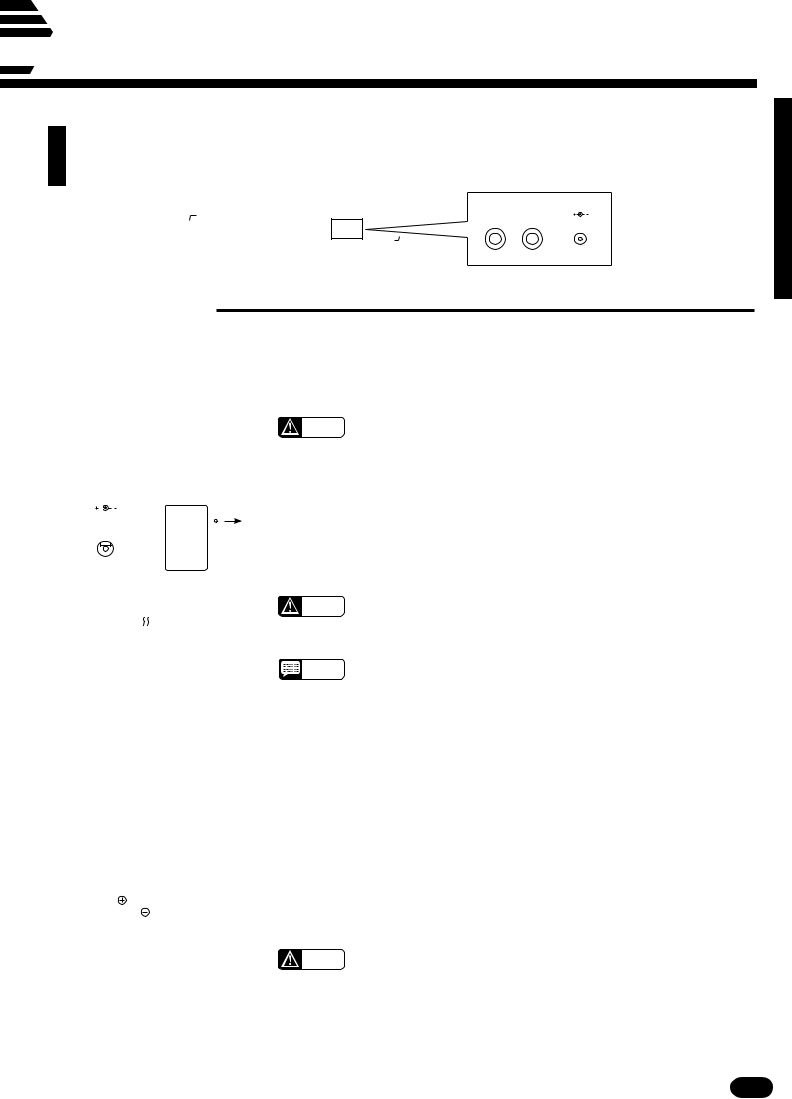
 Preparation
Preparation
This section contains information about setting up your PSR-410 and preparing to play.
Be sure to go through this section carefully before using your PSR-410.
SUSTAIN PEDAL |
HEADPHONES/ |
|
DC 10-12V IN |
||||||
|
AUX OUT |
|
|
|
|
|
|
|
|
|
|
|
|
|
|
|
|
|
|
|
|
|
|
|
|
|
|
|
|
|
|
|
|
|
|
|
|
|
|
|
|
|
|
|
|
|
|
|
|
■ Power Supply
Your PSR-410 will run either from an optional power adaptor or batteries*. Follow the instructions below according to the power source you intend to use.
*When batteries are used the sound of the PSR-410 may be distorted at high volume levels. This is because the power of the amplifier is reduced when batteries are used.
CAUTION
• Never interrupt the power supply (e.g. remove the batteries or unplug the AC adaptor) during any PSR-410 record operation! Doing so can result in a loss of data.
● Using An Optional AC Power Adaptor
DC 10-12V IN
|
|
|
|
|
|
|
|
|
|
|
|
|
|
|
|
PA-3, |
|
|
|
|
|
|
PA-4, |
|
|
||
|
|
|
||||
|
|
PA-5, |
AC power |
|||
|
|
|||||
|
|
PA-5B, |
|
socket |
||
|
|
or |
|
|
|
|
|
|
PA-40 |
|
|
|
|
|
|
|
|
|
||
|
|
|
|
|
|
|
|
|
|
|
|
|
|
|
|
|
|
|
|
|
|
|
|
|
|
|
|
.................................................................................................
Plug the DC output cable from an optional Yamaha PA-3, PA-4, PA-5, PA5B, or PA-40 AC Power Adaptor into the DC IN jack on the rear panel of the PSR-410, then plug the Power Adaptor (or the AC cable of the Power Adaptor) into a convenient wall AC power socket. The internal batteries are automatically disconnected when an AC Power Adaptor is used.
CAUTION |
• Use ONLY a Yamaha PA-3, PA-4, PA-5, PA-5B, or PA-40 AC Power |
|
Adaptor to power your instrument from the AC mains. The use of |
||
|
||
|
other adaptors may result in irreparable damage to both the adaptor |
|
|
and the PSR-410. |
|
NOTES |
• Using the PA-5 with the PSR-410 will provide a slight increase in the |
|
overall volume. |
||
|
● Using Batteries .......................................................................................................................................
For battery operation the PSR-410 requires six 1.5V SUM-1, “D” size, R-20 or equivalent batteries. When the batteries need to be replaced the volume may be reduced, the sound may be distorted, and other
problems may occur. When this happens, turn the power off while either the batteries are replaced or an AC adaptor is connected.
When the batteries fail, replace them as follows:
ZOpen the battery compartment cover located on the instrument’s bottom panel.
XInsert the six new batteries, being careful to follow the polarity markings on the inside of the compartment.
CReplace the compartment cover, making sure that it locks firmly in place.
CAUTION
• When the batteries run down, replace them with a complete set of six new batteries. NEVER mix old and new batteries.
•Do not use different kinds of batteries (e.g. alkaline and manganese) at the same time.
•To prevent possible damage due to battery leakage, remove the
batteries from the instrument if it is not to be used for an extended period of time.
| | | | | | | | | | | | | | | | | | | | | | | | | | | | | | | | | | | | | | | | | | | | | | | | | | | | | | | | | | | | | | | | | | | | | | | | | | | | | | | | | | | | | | | | | | | | | | | | | | | | | | | | | | | | | | | | | | | | | | | | | | | | | | | | | | | | | | | | | | | | | |
5 |
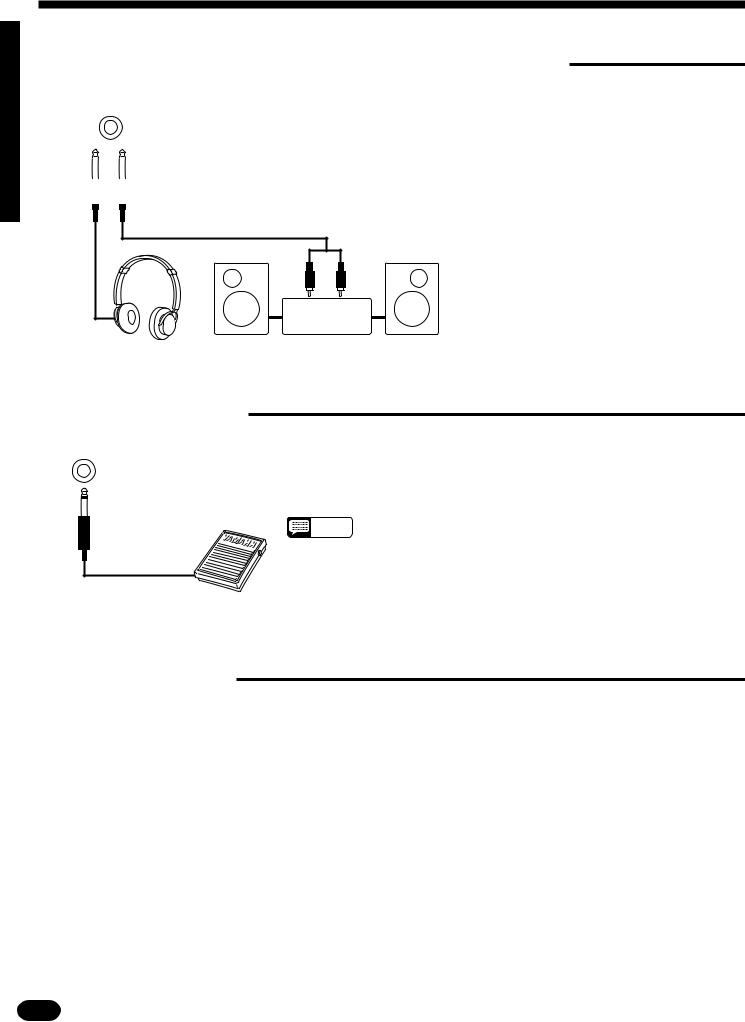
Preparation
■ Using Headphones Or an External Sound System
HEADPHONES/ |
|
|
||
|
AUX OUT |
|
|
|
|
|
|
|
|
|
|
|
|
|
|
|
|
|
|
|
|
|
|
|
A standard pair of stereo headphones can be plugged into the rear-panel HEADPHONES/AUX OUT jack for private practice or late-night playing. The internal speaker system is automatically shut off when a pair of headphones is plugged into the HEADPHONES/AUX OUT jack. The HEADPHONES/AUX OUT jack can also be used to deliver the output of the PSR-410 to a keyboard amplifier, stereo sound system, mixing console or tape recorder.
Stereo sound system
■ The Sustain Pedal
SUSTAIN PEDAL
An optional Yamaha FC4 or FC5 footswitch can be plugged into the rear-panel SUSTAIN PEDAL jack. The sustain pedal functions as a damper pedal, controlling sustain. Press the pedal to sustain notes after the keys are released.
NOTES |
• Be sure that you do not press the pedal while inserting the plug |
|
into the SUSTAIN PEDAL jack or while turning the power on. If |
||
|
||
|
you do, the ON/OFF status of the footswitch will be reversed. |
|
|
This function has been implemented to allow either press-to- |
|
|
make or press-to-break contact type footswitches to be used with |
|
|
the PSR-410. |
■ The Music Stand
Insert the bottom edge of the music stand into the slot located at the rear of the PSR-410 control panel.
6 | | | | | | | | | | | | | | | | | | | | | | | | | | | | | | | | | | | | | | | | | | | | | | | | | | | | | | | | | | | | | | | | | | | | | | | | | | | | | | | | | | | | | | | | | | | | | | | | | | | | | | | | | | | | | | | | | | | | | | | | | | | | | | | | | | | | | | | | | | | | |

Listen to the Demo!
Once you’ve set up your PSR-410, try listening to the pre-programmed demonstration songs — they’ll give you a good idea of what the PSR-410 can do!
DEMO
SONG #
|
|
|
ON/ |
|
|
|
OFF |
MIN |
MAX |
|
|
|
|
|
|
||||
|
POWER |
MASTER VOLUME |
|
||||||
START/STOP
ZTurn the Power ON & Set the Volume ..................................................................................................
Before playing the demo turn the power ON by pressing the POWER
|
|
switch (the panel indicators and MULTI DISPLAY will light), and turn the |
|
|
MASTER VOLUME control up (clockwise) about a quarter-turn from its |
|
|
minimum position. |
ON/ OFF |
MIN |
MAX |
POWER |
MASTER VOLUME |
|
XSelect a Song |
.......................................................................................................................................... |
|
DEMO
SONG #
START/STOP
Press the DEMO [SONG #] button a few times until the number of the desired demo song appears on the MULTI DISPLAY.
ALL (0): Repeat playback of all demo songs in sequence.
1~5: Repeat playback of the selected demo song number.
• “ALL” is automatically selected whenever the power switch is turned
NOTES
on.
CPress DEMO [START/STOP] to Start
DEMO
SONG #
START/STOP
....................................................................................................
Press the DEMO [START/STOP] button to start playback, and use the MASTER VOLUME control to set the ideal listening level. The selected demonstration will play repeatedly.
NOTES
• During demo playback you can select different voices and play along on the keyboard — see the “Selecting & Playing the Voices” section beginning on page 10.
VPress DEMO [START/STOP] to Stop ....................................................................................................
Press the DEMO [START/STOP] button again to stop demo playback.
| | | | | | | | | | | | | | | | | | | | | | | | | | | | | | | | | | | | | | | | | | | | | | | | | | | | | | | | | | | | | | | | | | | | | | | | | | | | | | | | | | | | | | | | | | | | | | | | | | | | | | | | | | | | | | | | | | | | | | | | | | | | | | | | | | | | | | | | | | | | | |
7 |
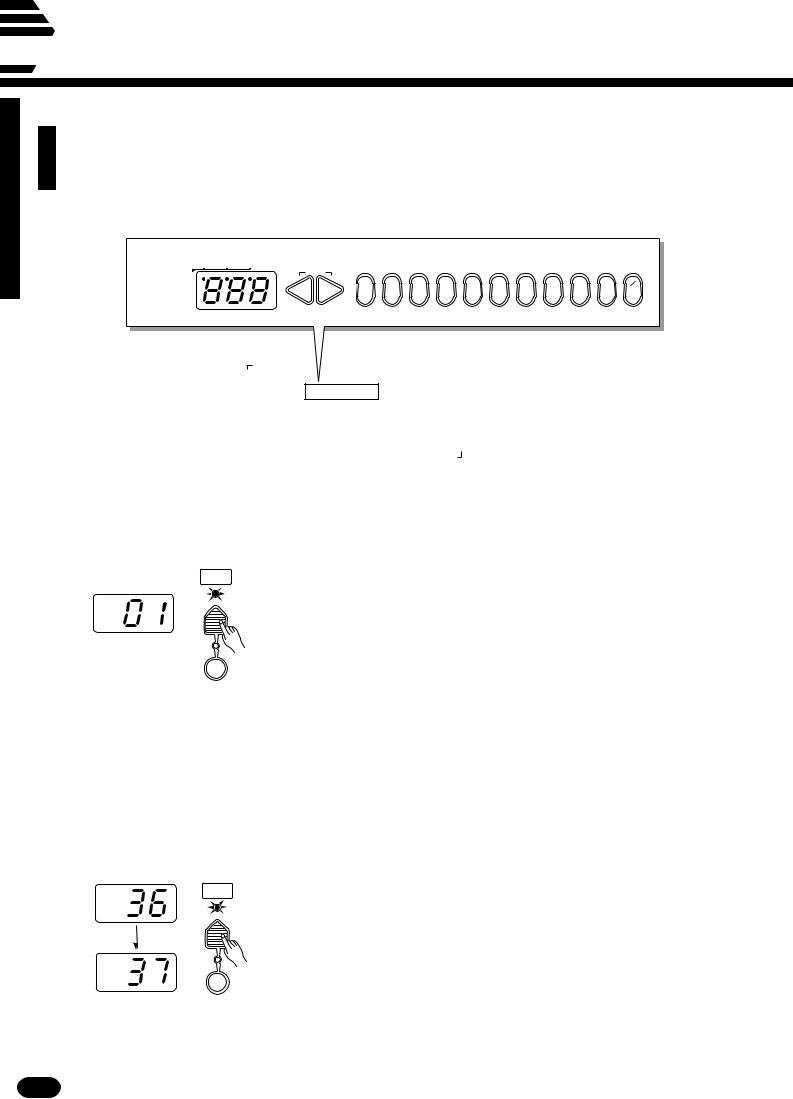
 Basic Editing Procedure
Basic Editing Procedure
The PSR-410 features a flexible-but-consistent interface that lets you edit just about all of its parameters using the same basic procedure. Once familiar with the system, you’ll be able to
edit any parameter quickly and easily. Here’s the basic procedure:
BEAT |
RESET |
|
|
|
|
|
|
|
|
|
|
|
MULTI DISPLAY |
|
|
|
|
|
|
|
|
|
|
|
|
– |
+ |
|
|
|
|
|
|
|
|
|
+– |
|
|
1 |
2 |
3 |
4 |
5 |
6 |
7 |
8 |
9 |
|||
|
|
0 |
1__ |
ZPress a Function Button
VOICE
SELECT
........................................................................................................................
First press the button corresponding to the function or parameter you want to edit. To select voice numbers, for example, press the [VOICE SELECT] button (its indicator will light). The number shown on the MULTI DISPLAY will be the current value of the selected parameter.
KEYBOARD
PERCUSSION
XEdit the Parameter ..................................................................................................................................
The PSR-410 lets you edit parameters using three different methods.
Use the one that best suits the parameter you have selected:
2-1: The Function Button
VOICE
SELECT
KEYBOARD
PERCUSSION
Each time you press a function button (except for the SPLIT POINT button) after initially selecting the function, the value of the corresponding parameter will be incremented (increased) by one. If you hold the function button for a few seconds, the parameter will begin to increment continuously as long as you hold the button.
If, for example, you press the [VOICE SELECT] button and MULTI DISPLAY shows that voice number 36 is currently selected, you can select voice number 37 simply by pressing the [VOICE SELECT] button again.
8 | | | | | | | | | | | | | | | | | | | | | | | | | | | | | | | | | | | | | | | | | | | | | | | | | | | | | | | | | | | | | | | | | | | | | | | | | | | | | | | | | | | | | | | | | | | | | | | | | | | | | | | | | | | | | | | | | | | | | | | | | | | | | | | | | | | | | | | | | | | | |
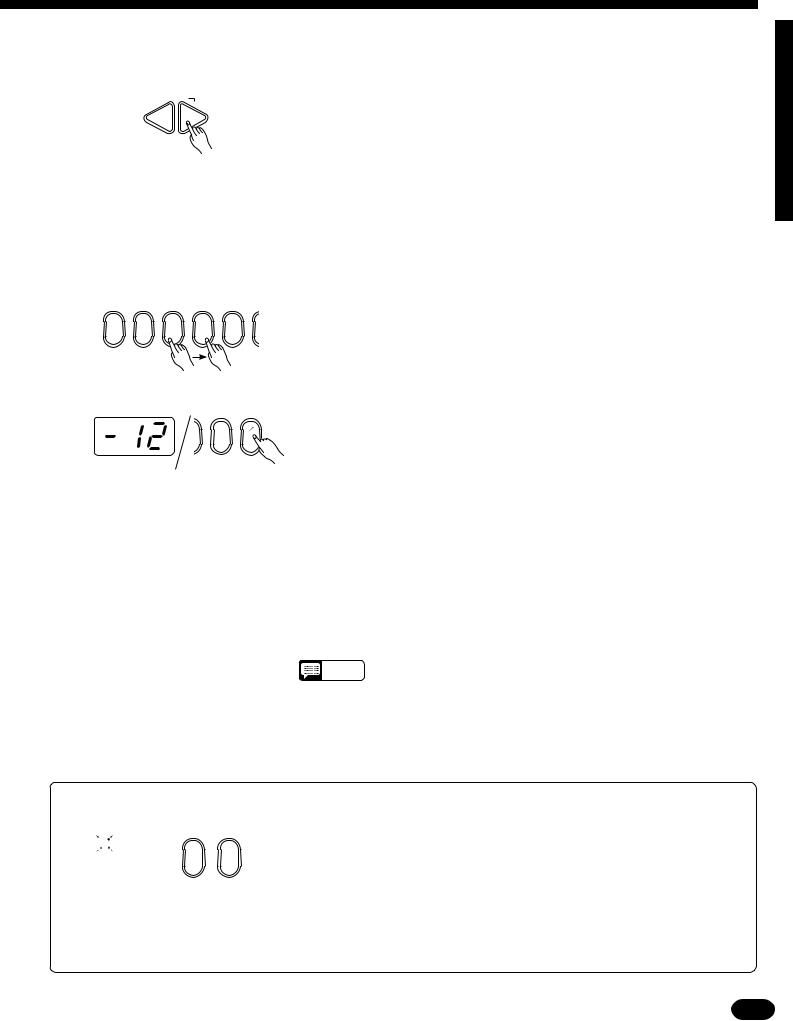
2-2: The [ + ] and [ − ] Buttons
 RESET
RESET
–+
2-3: The Number Buttons
0 |
1 |
2 |
3 |
4 |
+– 9 1__
The [+ ] and [− ] buttons immediately to the right of the MULTI DISPLAY can be used to increment (increase by one) or decrement (decrease by one) the currently selected parameter. Press the [+ ] button briefly to increment the parameter value, or the [− ] button to decrement. If you hold the [+ ] or [− ] button down, the value will increment or decrement continuously
— simply release the button when the desired value has been reached.
The number buttons — to the right of the [+ ] and [− ] buttons — allow direct numeric entry of the desired value, and are therefore the fastest way to edit in many situations.
To select a voice, for example, choose one of the 128 voices — numbered “01” through “128” — shown on the panel VOICE list, then enter its number using the number buttons. To select “HARMONICA” (number 23), for example, first press [2] then [3]. The number “23” should then appear on the MULTI DISPLAY.
The [+ /− ] button is used to switch between positive and negative values with parameters that allow negative values (Transpose, Tuning, Octave, and Pan, for example). A “− ” appears before negative values on the MULTI DISPLAY.
When selecting voice numbers the [+ /− ] button is used to enter the hundreds digit of the voice number (the button alternately selects no hundreds digit or “1”), as required, prior to entering the tens and ones digits. The [1] number button cannot be used to enter the hundreds digit when selecting voices.
Values outside the range of the selected parameter can not be entered.
NOTES |
• After editing a parameter other than [VOICE SELECT], the [VOICE |
|
SELECT] parameter will automatically be re-selected after a brief |
||
|
||
|
delay. |
●Yes/No Confirmation

 ARE YOU SURE ?
ARE YOU SURE ?
YES NO
•If you attempt to change a parameter that can not be edited in the current mode, “---” will appear on the MULTI DISPLAY.
Some operations that change important settings or erase data may require you
to confirm your choice by pressing the [YES] or [NO] button. When a choice needs to be confirmed the ARE YOU SURE? indicator will flash and a digitally sampled
voice will ask “Are you sure?”. Press the [YES] button to execute the specified operation or the [NO] button to cancel and leave the settings or data unaffected.
If you don’t want to hear the “Are you sure?” confirmation sound, hold down the [NO] button while initially turning the power switch on. To restore the confirmation sound, turn the power switch off, then turn it back on again while holding down the [YES] button. The on/off status of the confirmation sound is retained in memory even when the power switch is turned off as long as batteries are installed on an
AC adaptor is connected.
| | | | | | | | | | | | | | | | | | | | | | | | | | | | | | | | | | | | | | | | | | | | | | | | | | | | | | | | | | | | | | | | | | | | | | | | | | | | | | | | | | | | | | | | | | | | | | | | | | | | | | | | | | | | | | | | | | | | | | | | | | | | | | | | | | | | | | | | | | | | | |
9 |
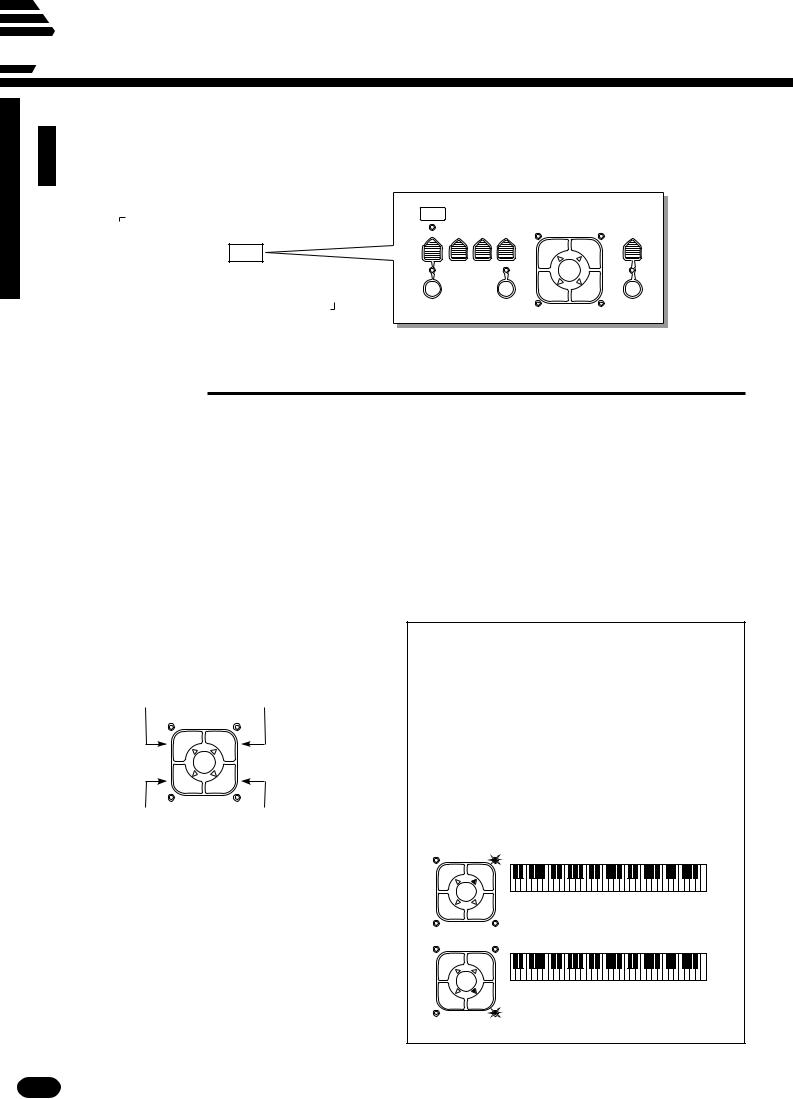
 Selecting & Playing the Voices
Selecting & Playing the Voices
The PSR-410 has 128 stunning voices plus 8 different drum and percussion kits that you can select and play in a number of ways.
VOICE |
VOICE |
|
|
SELECT |
ORCHESTRATION |
HARMONY |
|
VOL OCTAVE PAN |
|||
|
|
|
TYPE |
|
|
|
L1 |
R1 |
|
|
|
|
EDIT |
|
|
|
L2 |
R2 |
KEYBOARD |
|
ONE TOUCH |
|
HARMONY |
PERCUSSION |
|
SETTING |
|
|
■ Orchestration
The unique ORCHESTRATION button group in the PSR-410’s VOICE control section lets you select and play from one to four “parts” at the same time using a variety of “orchestrations”. One of the PSR-410’s 128 voices is assigned to each part.
●Single: One voice over the entire keyboard.
●Dual: Two voices simultaneously over the entire keyboard.
●Split: Different voices with the left and right hands.
●Split & Dual: Combinations of the Split and Dual modes.
There are actually a number of variations on each of the above orchestrations. The ORCHESTRATION buttons are used to choose the type of orchestration you want.
|
Right-hand voice 1 |
Left-hand voice 1 |
(or single voice) |
ORCHESTRATION |
|
L1 |
R1 |
EDIT |
|
L2 |
R2 |
Left-hand voice 2 |
Right-hand voice 2 |
|
(or single voice) |
The four available parts are turned on and off by the [R1], [R2], [L1], and [L2] buttons. The indicators next to each of these buttons tell you which parts are on and which are off, and therefore indicate the current orchestration mode. The [EDIT] button determines which of the four orchestration parts is to be edited. You can, for example, assign any of the PSR-410’s 128 voices to each of the orchestration parts. But before we discuss voice assignment and editing, let’s take a look at the various orchestration modes:
● Single Modes
In the “single” modes either the |
[R1]or [R2]part |
||
voice can be played over the entire keyboard. The R1 |
|||
and R2 single-voice modes are selected simply by |
|
||
pressing either the |
[R1]or [R2]button if neither the |
||
[L1] or |
[L2] indicators are lit. If the |
[L1] and/or [L2] |
|
indicators are lit, press them so that both indicators |
|||
go out. |
|
|
|
Note that when you select the |
[R1]or [R2]single- |
||
voice mode, the triangular EDIT indicator for the se- |
|||
lected voice also lights. This means you can select a |
|
||
different voice number or otherwise edit the current |
|||
voice using the procedures described on page 12. |
|
||
L1 |
R1 |
|
|
|
EDIT |
|
|
L2 |
R2 |
The R1 voice is played across the |
|
entire keyboard. |
|
||
|
|
|
|
L1 |
R1 |
|
|
|
EDIT |
|
|
L2 |
R2 |
The R2 voice is played across the |
|
|
|
||
entire keyboard.
10 | | | | | | | | | | | | | | | | | | | | | | | | | | | | | | | | | | | | | | | | | | | | | | | | | | | | | | | | | | | | | | | | | | | | | | | | | | | | | | | | | | | | | | | | | | | | | | | | | | | | | | | | | | | | | | | | | | | | | | | | | | | | | | | | | | | | | | | | | | | | |
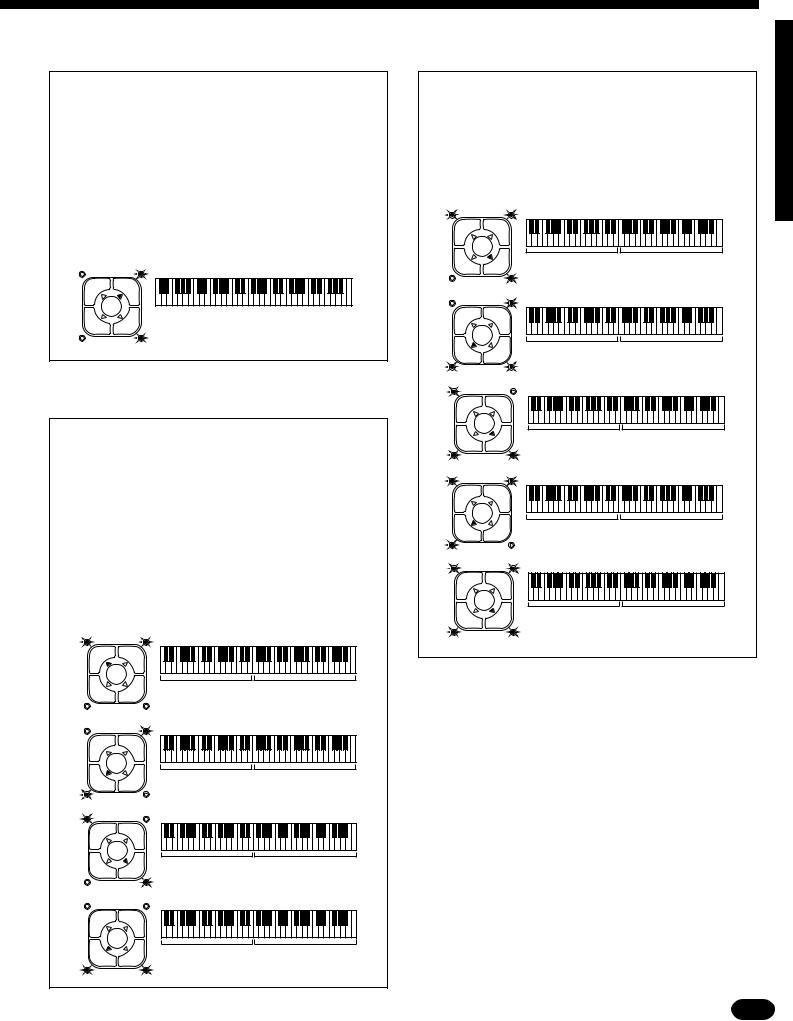
● Dual Mode
In the dual mode both the |
[R1]and [R2]part |
|
voices are selected so they can be played simultane- |
|
|
ously across the entire keyboard. To select the dual |
|
|
mode, make sure that both the |
[L1] and |
[L2] indica- |
tors are out, then press both the |
[R1]and |
[R2]but- |
tons simultaneously (or hold one while pressing the other).
You can switch back to either of the single modes
from the dual mode simply by pressing the [R1]or [R2]button, as required.
L1 |
R1 |
|
|
|
EDIT |
|
|
L2 |
R2 |
The R1 & |
R2 voices are played |
|
|
across the |
entire keyboard. |
● Split Modes
The PSR-410 allows four different split modes, with one voice played on the left-hand section of the
keyboard ( [L1] or [L2]) and a different voice on the
right-hand section of the keyboard ( |
[R1]or [R2]). |
Selecting a split mode is simply a matter of pressing |
|
the buttons corresponding to the desired leftand |
|
right-hand parts. |
|
The split point (i.e. the key at which the voices change over) can be set at any desired key by using the SPLIT POINT CHANGE function described on page 18.
|
|
|
▼ |
L1 |
R1 |
|
|
|
EDIT |
|
|
L2 |
R2 |
L1 voice. |
R1 voice. |
|
|
|
▼ |
L1 |
R1 |
|
|
|
EDIT |
|
|
L2 |
R2 |
L2 voice. |
R1 voice. |
|
|
|
▼ |
L1 |
R1 |
|
|
|
EDIT |
|
|
L2 |
R2 |
L1 voice. |
R2 voice. |
|
|
|
▼ |
L1 |
R1 |
|
|
|
EDIT |
|
|
L2 |
R2 |
L2 voice. |
R2 voice. |
● Split & Dual Modes
There are five possible combinations of the split and dual modes, as shown below. The part for the single-voice side of the combination is selected simply by pressing the appropriate part button, while for the dual-voice side both buttons must be pressed simultaneously (or one while holding the other).
|
|
|
▼ |
L1 |
R1 |
|
|
|
EDIT |
|
|
L2 |
R2 |
L1 voice. |
R1 & R2 voices. |
|
|
|
▼ |
L1 |
R1 |
|
|
|
EDIT |
|
|
L2 |
R2 |
L2 voice. |
R1 & R2 voices. |
|
|
|
▼ |
L1 |
R1 |
|
|
|
EDIT |
|
|
L2 |
R2 |
L1 & L2 voices. |
R2 voice. |
|
|
|
▼ |
L1 |
R1 |
|
|
|
EDIT |
|
|
L2 |
R2 |
L1 & L2 voices. |
R1 voice. |
|
|
|
▼ |
L1 |
R1 |
|
|
|
EDIT |
|
|
L2 |
R2 |
L1 & L2 voices. |
R1 & R2 voices. |
| | | | | | | | | | | | | | | | | | | | | | | | | | | | | | | | | | | | | | | | | | | | | | | | | | | | | | | | | | | | | | | | | | | | | | | | | | | | | | | | | | | | | | | | | | | | | | | | | | | | | | | | | | | | | | | | | | | | | | | | | | | | | | | | | | | | | | | | | | | | | |
11 |
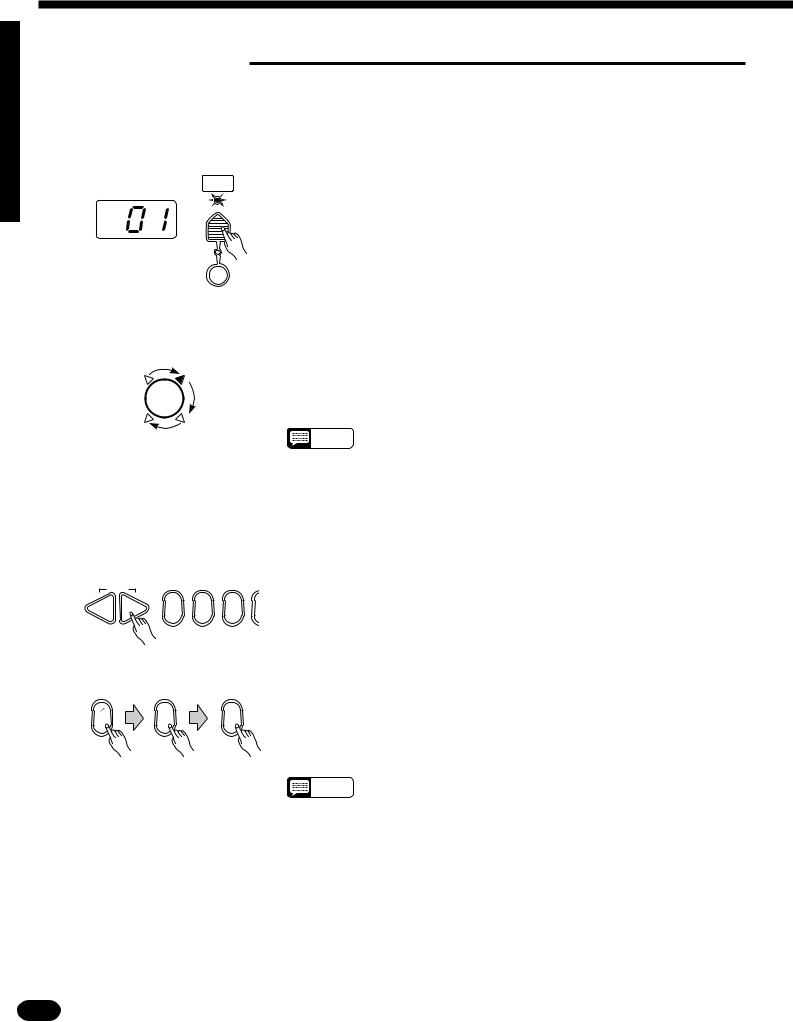
Selecting & Playing the Voices
■ Voice Assignment
You can assign any of the PSR-410’s 128 voices to each of the ORCHESTRATION parts, whether the part is currently ON or OFF.
ZPress the [VOICE SELECT] Button
VOICE
SELECT
KEYBOARD
PERCUSSION
XSelect the Part You Want to Edit
 EDIT
EDIT
.......................................................................................................
You don’t need to do this if the [VOICE SELECT] indicator is already lit. Also make sure that the [KEYBOARD PERCUSSION] indicator is out.
...........................................................................................................
Use the ORCHESTRATION [EDIT] button to select the part to which you want to assign a new voice. The [EDIT] indicators light in sequence in the clockwise direction each time the [EDIT] button is pressed.
NOTES |
• You can edit the voice number of a part that is OFF while playing a |
|
different part. |
||
|
||
|
• Actually, the [VOICE SELECT] mode is automatically selected when- |
|
|
ever the [EDIT] button is pressed, so you don’t really need to press |
|
|
[VOICE SELECT] as described in step 1 if you’re going to use the |
|
|
[EDIT] button prior to selecting a voice number. |
CSelect a Voice Number ...........................................................................................................................
|
|
|
Referring to the VOICE list printed on the PSR-410 panel, use the [+ ] |
RESET |
|
|
and [− ] buttons, the number buttons, or the [VOICE SELECT] button |
– + |
|
|
|
0 1 |
2 |
itself to select the required voice number (see page 8 for editing procedure |
|
|
|
|
details). |
Example: |
Voice number “120” |
When entering voice numbers higher than 99, use the [+ /− ] button to |
|
+– |
|
|
enter the hundreds digit prior to entering the tens and ones digits: the button |
|
|
alternately selects no hundreds digit or “1”. |
|
1__ |
2 |
0 |
|
NOTES |
• The optimum keyboard range is preset for each voice. |
|
12 | | | | | | | | | | | | | | | | | | | | | | | | | | | | | | | | | | | | | | | | | | | | | | | | | | | | | | | | | | | | | | | | | | | | | | | | | | | | | | | | | | | | | | | | | | | | | | | | | | | | | | | | | | | | | | | | | | | | | | | | | | | | | | | | | | | | | | | | | | | | |
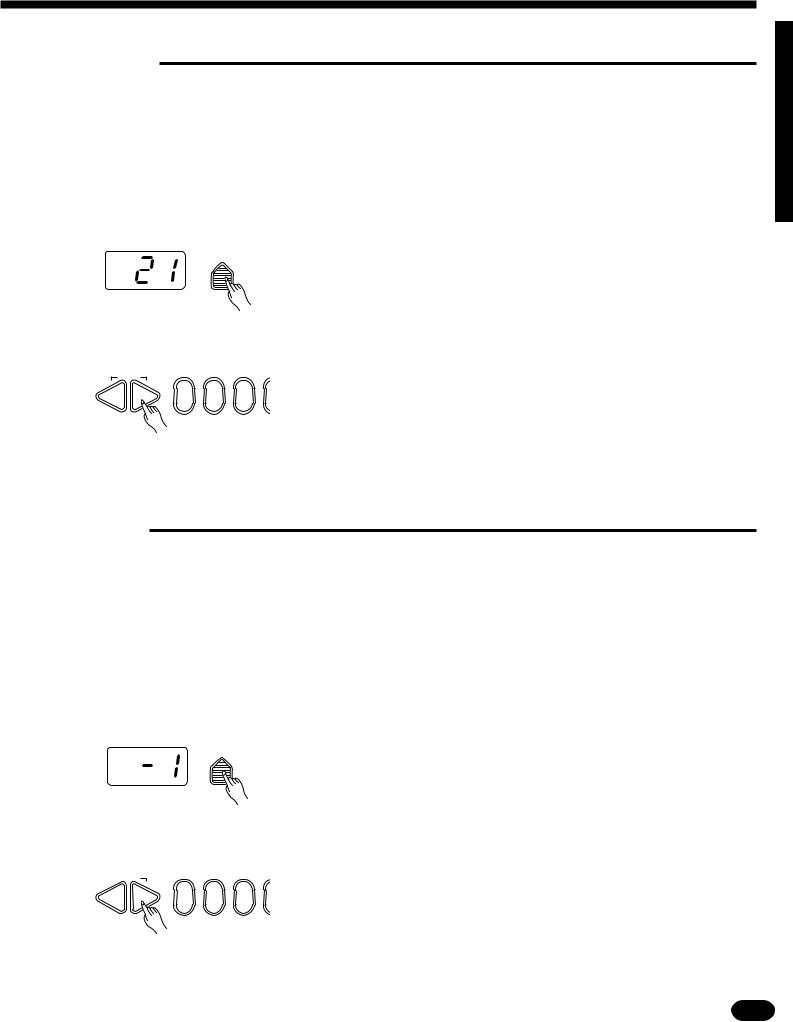
■ Volume
You can individually set the volume of each orchestration part to set up the ideal balance between parts.
ZSelect the Part You Want to Edit ...........................................................................................................
Use the ORCHESTRATION [EDIT] button to select the part you want to edit.
XPress the [VOL] Button
VOL
..........................................................................................................................
Press the VOICE control section [VOL] button. The current volume value of the selected part will appear on the MULTI DISPLAY.
CSet the Volume .......................................................................................................................................
RESET |
|
Use the [+ ] and [− ] buttons, the number buttons, or the [VOL] button |
|
itself to set the desired volume. The volume range is from 00 (no sound) to |
|
– + |
|
|
|
24 (maximum volume). The default volume value (21) can be recalled in- |
|
0 1 |
2 |
stantly by pressing both the [+ ] and [− ] buttons at the same time.
■ Octave
You can individually shift the octave of each orchestration part up or down by up to two octaves. This makes it easy, for example, to lower the pitch of a bass voice to an appropriate octave without affecting the other parts in your orchestration.
ZSelect the Part You Want to Edit ...........................................................................................................
Use the ORCHESTRATION [EDIT] button to select the part you want to edit.
XPress the [OCTAVE] Button ..................................................................................................................
OCTAVE
Press the VOICE control section [OCTAVE] button. The current octave value of the selected part will appear on the MULTI DISPLAY.
CSet the Octave
 RESET
RESET
– +
........................................................................................................................................
Use the [+ ] and [− ] buttons, the number buttons, or the [OCTAVE] button itself to set the desired octave. The octave range is from − 2 (down two octaves) to + 2 (up two octaves). The normal octave value for the selected
0 1 2
voice can be recalled instantly by pressing both the [+ ] and [− ] buttons at the same time.
| | | | | | | | | | | | | | | | | | | | | | | | | | | | | | | | | | | | | | | | | | | | | | | | | | | | | | | | | | | | | | | | | | | | | | | | | | | | | | | | | | | | | | | | | | | | | | | | | | | | | | | | | | | | | | | | | | | | | | | | | | | | | | | | | | | | | | | | | | | | | |
13 |

Selecting & Playing the Voices
■ Pan
The PSR-410 delivers true stereo sound, and you can use this parameter to individually set the stereo (pan) position of each orchestration part to create a broad stereo image of your sound.
ZSelect the Part You Want to Edit ...........................................................................................................
Use the ORCHESTRATION [EDIT] button to select the part you want to edit.
XPress the [PAN] Button ..........................................................................................................................
PAN |
Press the VOICE control section [PAN] button. The current pan value of |
|
|
|
the selected part will appear on the MULTI DISPLAY. |
CSet the Pan Position
 RESET
RESET
–+
...............................................................................................................................
Use the [+ ] and [− ] buttons, the number buttons, or the [PAN] button itself to set the desired pan value. The pan range is from − 7 (full left) to + 7 (full right). A setting of “0” places the sound of the selected part in the
0 1 2 center of the stereo sound field. Other settings produce in-between positions. “− 4”, for example, would place the sound between center and full left.
The center pan position (0) can be recalled instantly by pressing both the [+ ] and [− ] buttons at the same time.
NOTES • The new pan value will apply from the next note played — i.e. you can’t pan the sound of a note while it is playing.
14 | | | | | | | | | | | | | | | | | | | | | | | | | | | | | | | | | | | | | | | | | | | | | | | | | | | | | | | | | | | | | | | | | | | | | | | | | | | | | | | | | | | | | | | | | | | | | | | | | | | | | | | | | | | | | | | | | | | | | | | | | | | | | | | | | | | | | | | | | | | | |
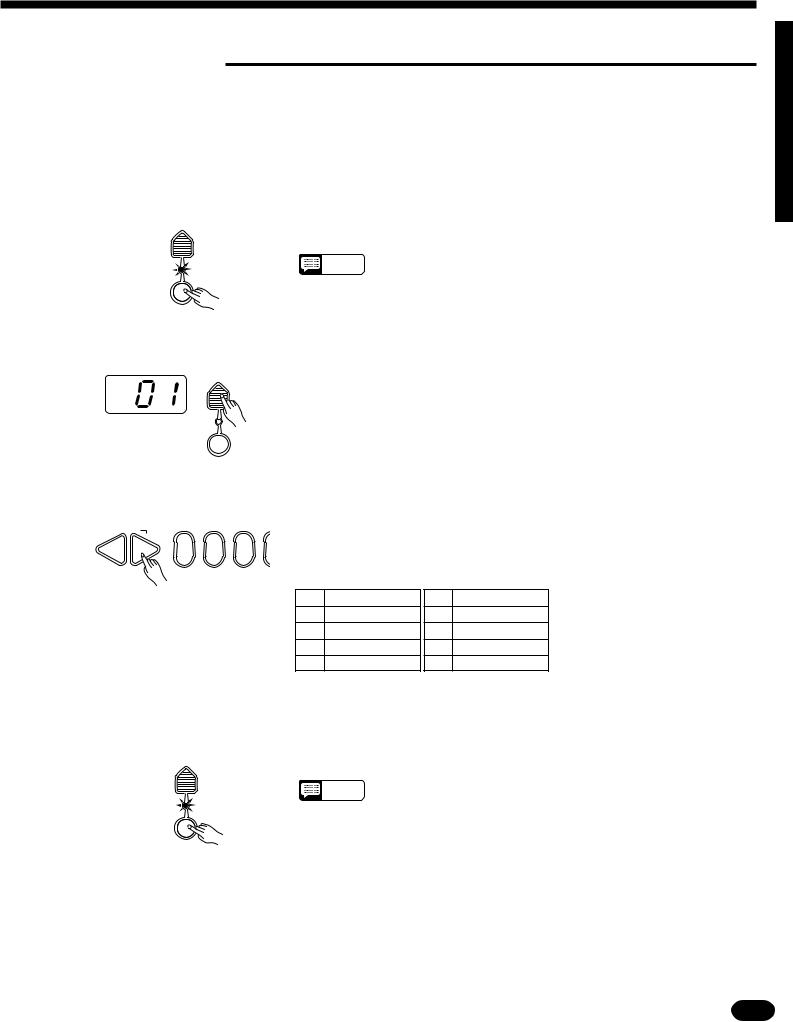
■ Auto Harmony
Auto Harmony is used with the PSR-410’s Auto Accompaniment feature except for Full fingering mode (see page 20). It automatically adds appropriate harmony notes to a single-note melody line you play on the keyboard. You can choose from 10 different types of harmony that can be assigned to the right-hand orchestration parts.
ZTurn Auto Harmony ON .........................................................................................................................
HARMONY |
Press the [HARMONY] button so that its indicator lights. This turns |
|
TYPE |
|
|
|
Auto Harmony ON. |
|
|
NOTES |
• The HARMONY can’t be engaged when Keyboard Percussion is ON. |
|
|
|
HARMONY |
|
|
XPress the [HARMONY TYPE] Button |
|
.................................................................................................... |
HARMONY |
Press the VOICE control section [HARMONY TYPE] button. The |
|
TYPE
number of the currently selected harmony type will appear on the MULTI DISPLAY.
HARMONY
CSelect a Harmony Type ..........................................................................................................................
Use the [+ ] and [− ] buttons, the number buttons, or the [HARMONY
 RESET
RESET
– + |
|
TYPE] button itself to select the desired effect. |
|||
1 |
2 |
|
|
|
|
0 |
|
|
|
||
|
|
The Harmony Types |
|
|
|
|
|
01 |
Duet |
06 |
4-way close 1 |
|
|
02 |
1 + 5 |
07 |
4-way close 2 |
|
|
03 |
Country |
08 |
4-way open |
|
|
04 |
Trio |
09 |
Octave |
|
|
05 |
Block |
10 |
Strum |
VTurn Auto Harmony ON or OFF as Required .......................................................................................
Use the [HARMONY] button to turn Auto Harmony ON or OFF. Auto
HARMONY
TYPE |
Harmony is ON when the [HARMONY] button indicator is lit. |
|
|
||
|
NOTES |
• When Auto Harmony is used in the dual mode, the R1 voice responds |
to notes played on the keyboard while the harmony notes are played by the R1 and R2 voices, depending on the selected harmony type.
• Only a single note can be played at a time on the keyboard (or the
HARMONY
right-hand section of the keyboard) when the Auto Harmony feature is used.
•If you play more than one note at the same time while Auto Harmony is ON, only the highest note will sound.
•Auto Harmony will only function when the Auto Accompaniment function is being used (page 20).
| | | | | | | | | | | | | | | | | | | | | | | | | | | | | | | | | | | | | | | | | | | | | | | | | | | | | | | | | | | | | | | | | | | | | | | | | | | | | | | | | | | | | | | | | | | | | | | | | | | | | | | | | | | | | | | | | | | | | | | | | | | | | | | | | | | | | | | | | | | | | |
15 |
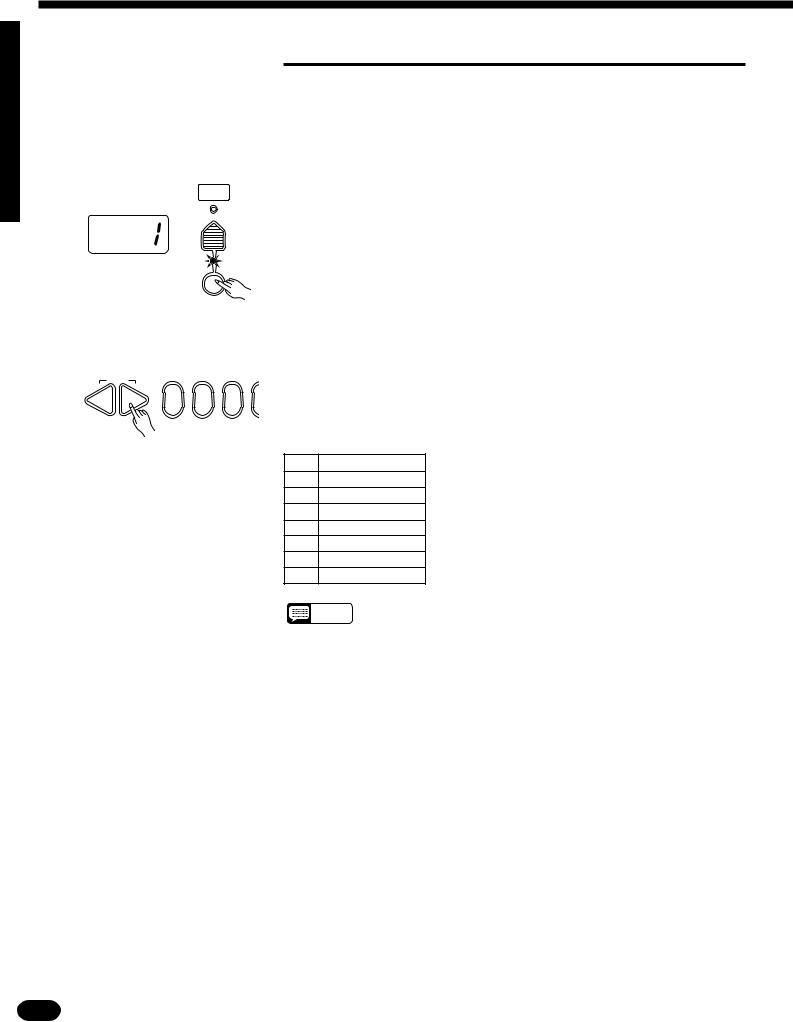
Selecting & Playing the Voices
■ Keyboard Percussion
The PSR-410 has 8 different drum and percussion “kits” that can be played on the keyboard when the Keyboard Percussion function is turned ON. The types of drum and percussion instruments played by the various keys when Keyboard Percussion function is selected are marked by symbols above the keys.
ZTurn Keyboard Percussion ON |
............................................................................................................. |
VOICE |
Press the [KEYBOARD PERCUSSION] button so that its indicator |
SELECT |
lights to turn Keyboard Percussion ON. The percussion kit number will |
|
|
|
appear on the MULTI DISPLAY. |
KEYBOARD
PERCUSSION
XSelect a Percussion Kit ..........................................................................................................................
|
|
Use the [+ ] and [− ] buttons, the number buttons, or the [VOICE SE- |
|
RESET |
|
LECT] button to select the desired percussion kit (1 through 8). See page |
|
– + |
|
||
2 |
218 for a complete list of the percussion kit instruments. |
||
0 1 |
The Percussion Kits
1Standard
2Room
3Rock
4Electronic
5Analog
6Jazz
7Brush
8Classic
NOTES |
• The HARMONY and TRANSPOSE functions (pages 15 and 19) do |
|
not affect the percussion sounds. The HARMONY function will be |
||
|
||
|
canceled when Keyboard Percussion is turned ON. |
|
|
• The ORCHESTRATION [EDIT] button does not function when Key- |
|
|
board Percussion is turned ON. |
16 | | | | | | | | | | | | | | | | | | | | | | | | | | | | | | | | | | | | | | | | | | | | | | | | | | | | | | | | | | | | | | | | | | | | | | | | | | | | | | | | | | | | | | | | | | | | | | | | | | | | | | | | | | | | | | | | | | | | | | | | | | | | | | | | | | | | | | | | | | | | |

■ Pitch Bend
PITCH BEND
+
–
● Setting the Pitch Bend Range
The PITCH BEND wheel to the left of the keyboard allows the note pitch to be bent up or down — roll the wheel away from you to bend up, and toward you to bend down (this situation can be reversed, as described below). When the PITCH BEND wheel is moved almost all the way in either direction, the current pitch bend range value will appear on the MULTI DISPLAY (see below).
The maximum amount of pitch bend produced by the PITCH BEND wheel can be set anywhere from ± 1 semitone to ± 12 semitones (i.e. plus or minus one octave).
ZCall the Pitch Bend Range Parameter ..................................................................................................
|
PITCH BEND |
|
To set the pitch bend range, roll the PITCH BEND wheel all the way in |
|
|
|
|
|
|
|
|
|
|
either direction so that the current range value appears on the MULTI DIS- |
|
|
|
|
PLAY. |
|
|
|
+ |
|
|
|
|
|
– |
|
|
|
|
|
|
|
|
|
|
|
|
|
|
|
|
|
|
|
|
|
|
|
|
|
|
|
|
|
|
|
|
|
|
|
|
|
|
|
|
|
|
|
|
|
|
|
|
|
|
|
|
|
|
|
|
|
|
|
|
|
|
|
|
|
XSet the Pitch Bend Range |
|
|
...................................................................................................................... |
|
|
|
While holding the PITCH BEND wheel at its maximum position, use |
RESET |
|
|
the [+ ] and [− ] buttons or the number buttons to select the desired pitch |
– + |
1 |
2 |
bend range. The pitch bend range value is displayed in semitones (− 12 |
0 |
through 12). If a minus setting is selected pitch bend wheel operation is |
||
|
|
|
reversed — i.e. roll the wheel away from you to lower pitch. The default pitch bend range (02) can be instantly recalled by pressing [+ ] and
[− ] buttons simultaneously.
CRelease the PITCH BEND Wheel ...........................................................................................................
Release the PITCH BEND wheel when you’ve set the required pitch bend range.
■ Sustain
SUSTAIN PEDAL
If you have plugged an optional Yamaha FC4 or FC5 footswitch into the PSR-410’s rear-panel SUSTAIN PEDAL jack, the footswitch can be used as a damper pedal, controlling sustain. Press the pedal to sustain notes after the keys are released.
|
|
|
|
|
17 |
|
|
|
|
|
|
|
|
|
|
|
|
| | | | | | | | | | | | | | | | | | | | | | | | | | | | | | | | | | | | | | | | | | | | | | | | | | | | | | | | | | | | | | | | | | | | | | | | | | | | | | | | | | | | | | | | | | | | | | | | | | | | | | | | | | | | | | | | | | | | | | | | | | | | | | | | | | | | | | | | | | | | | |
|||||
